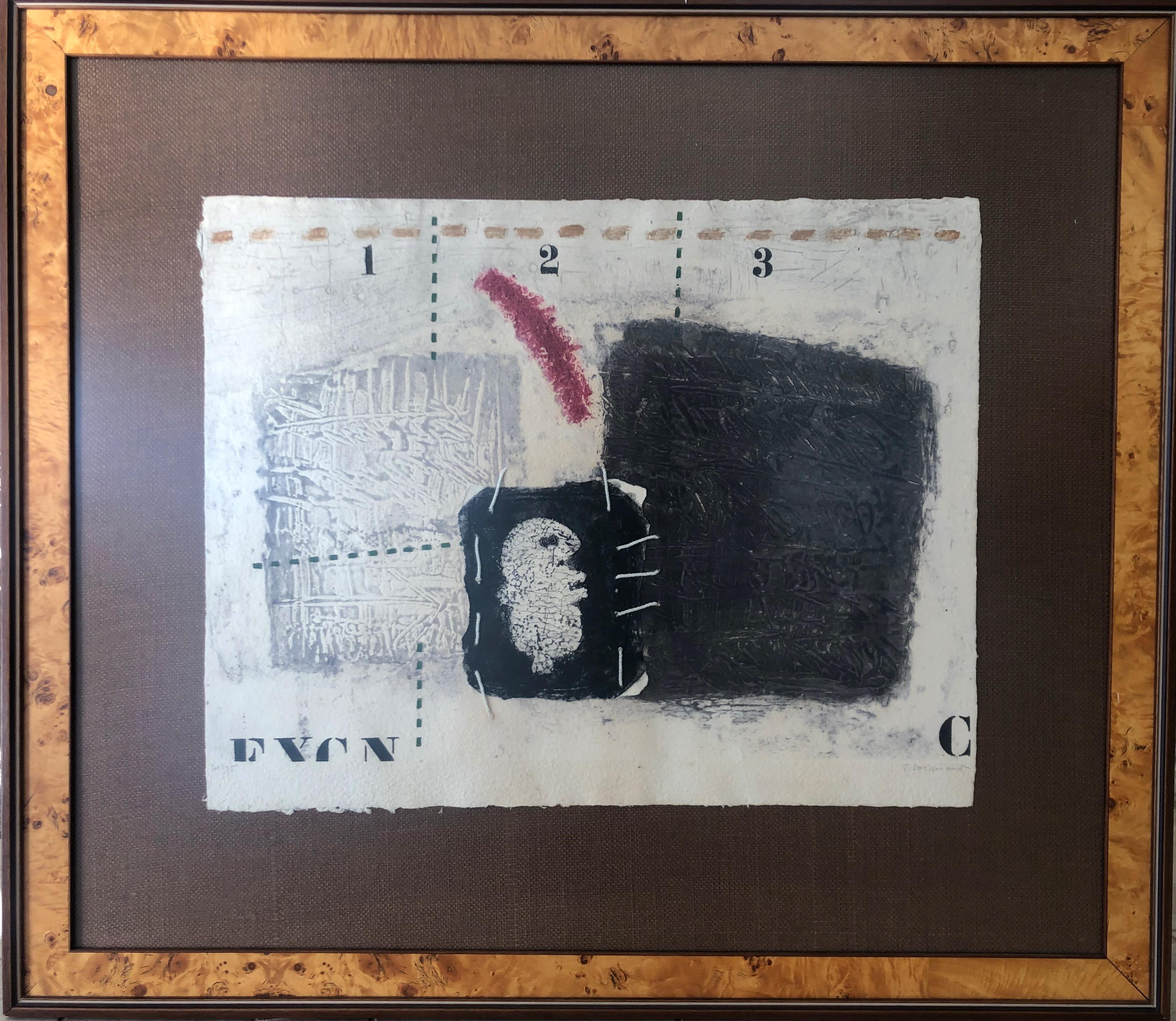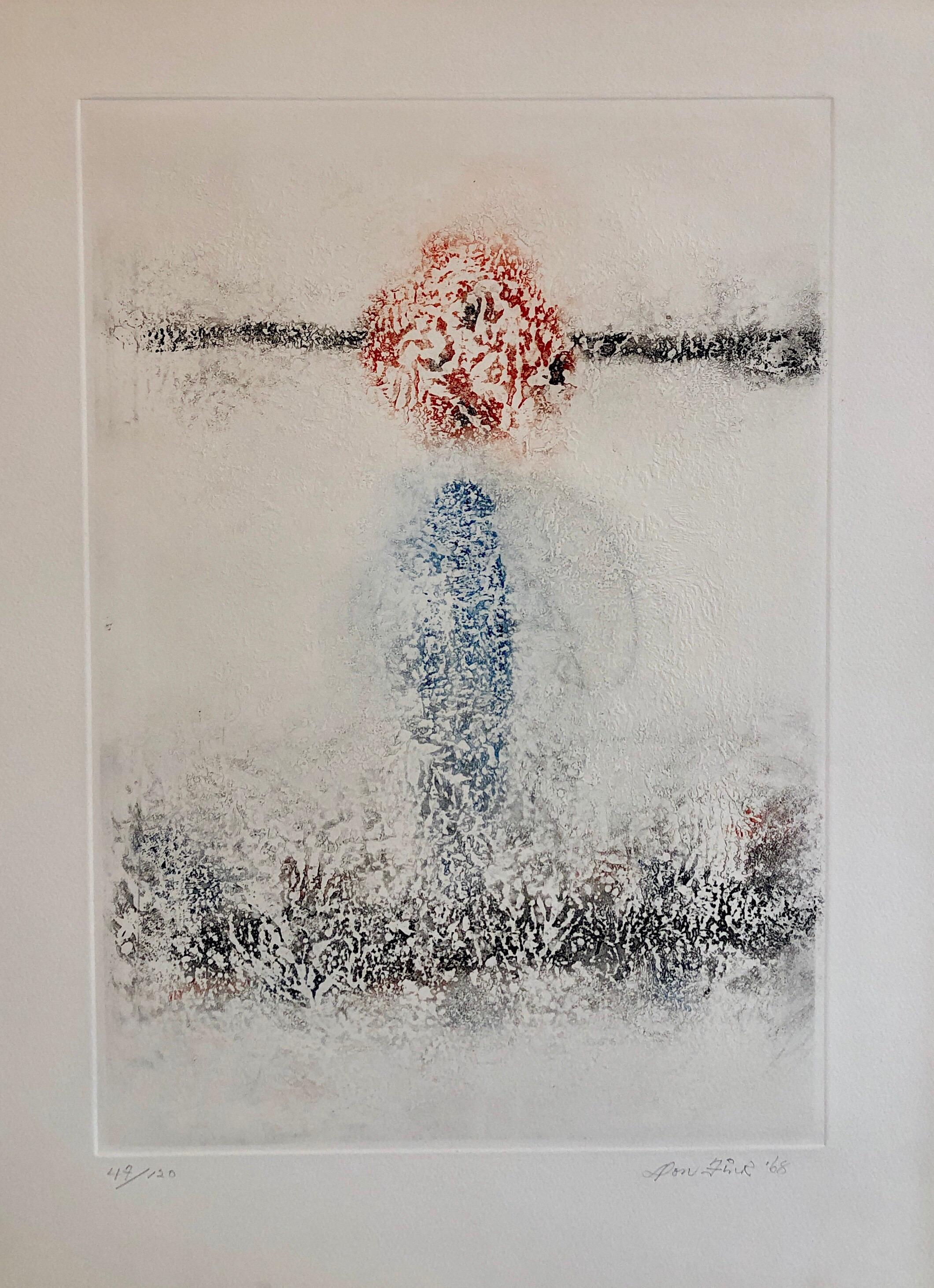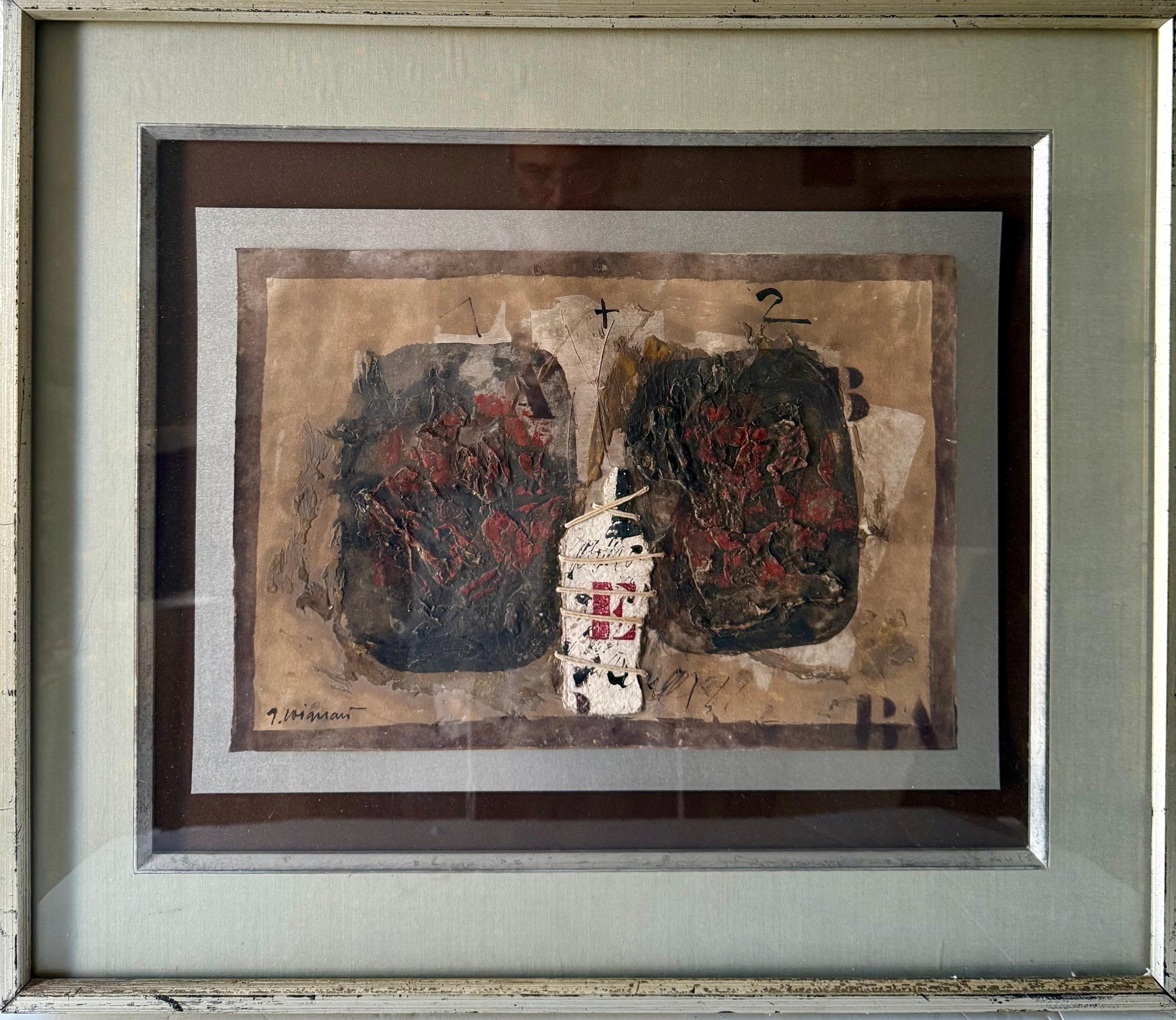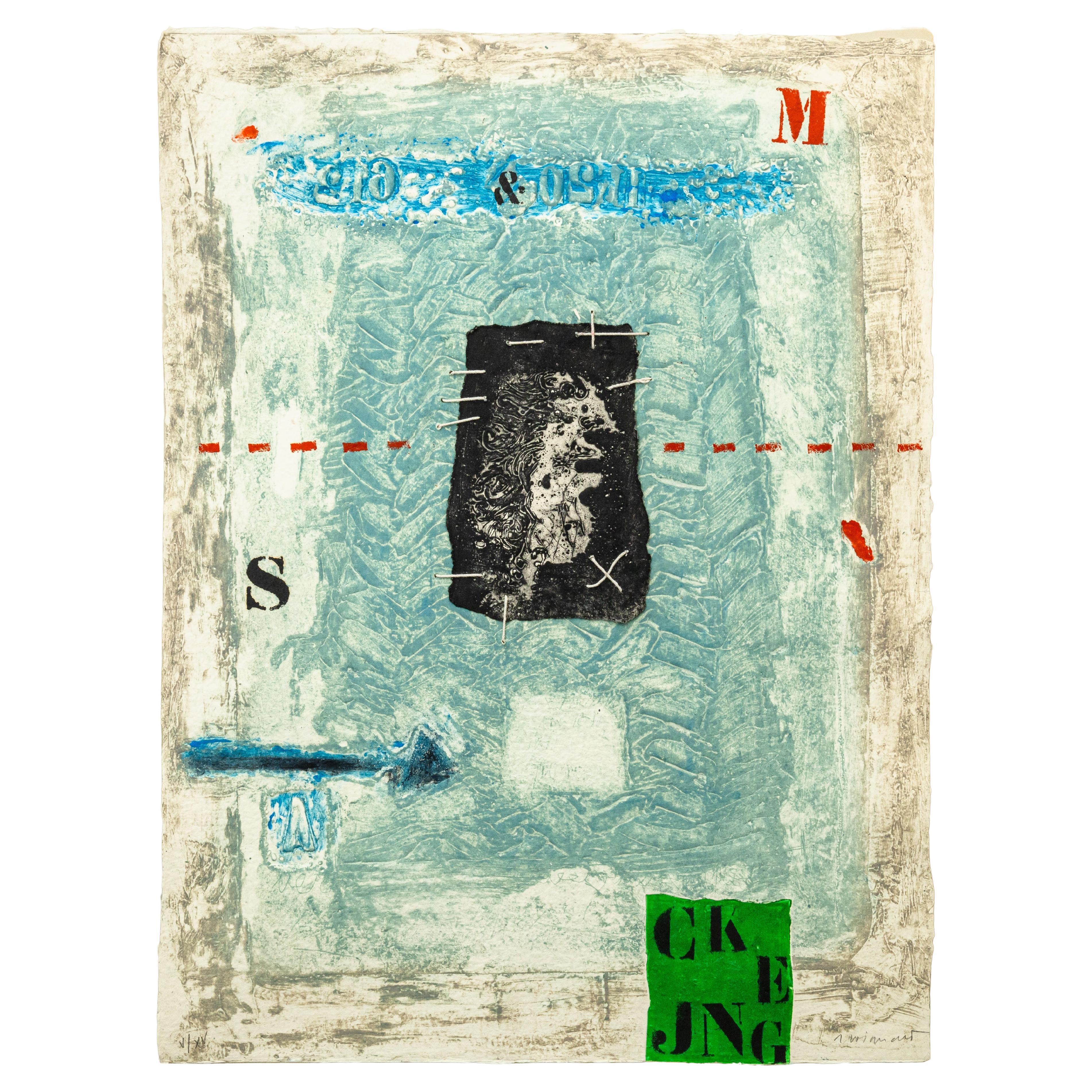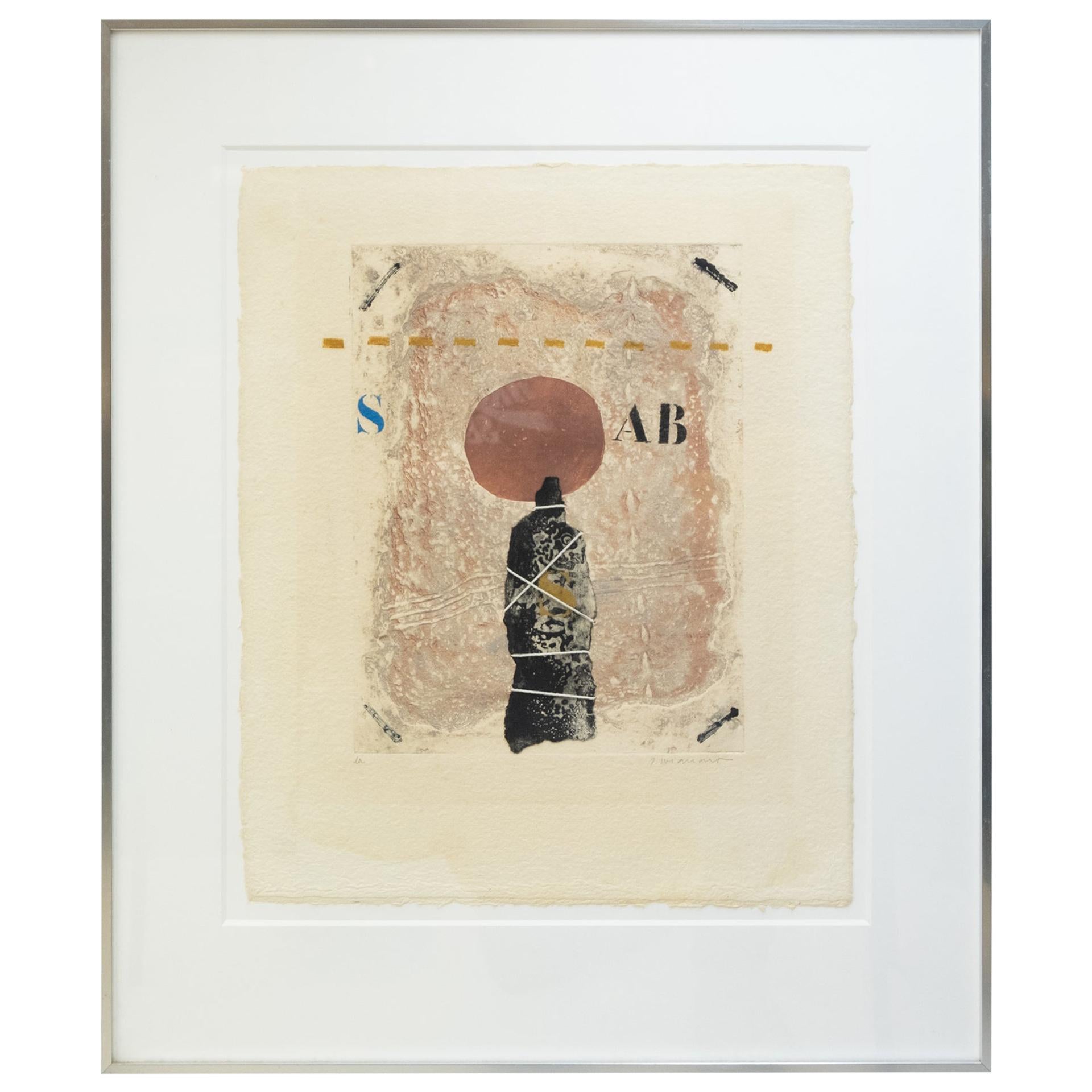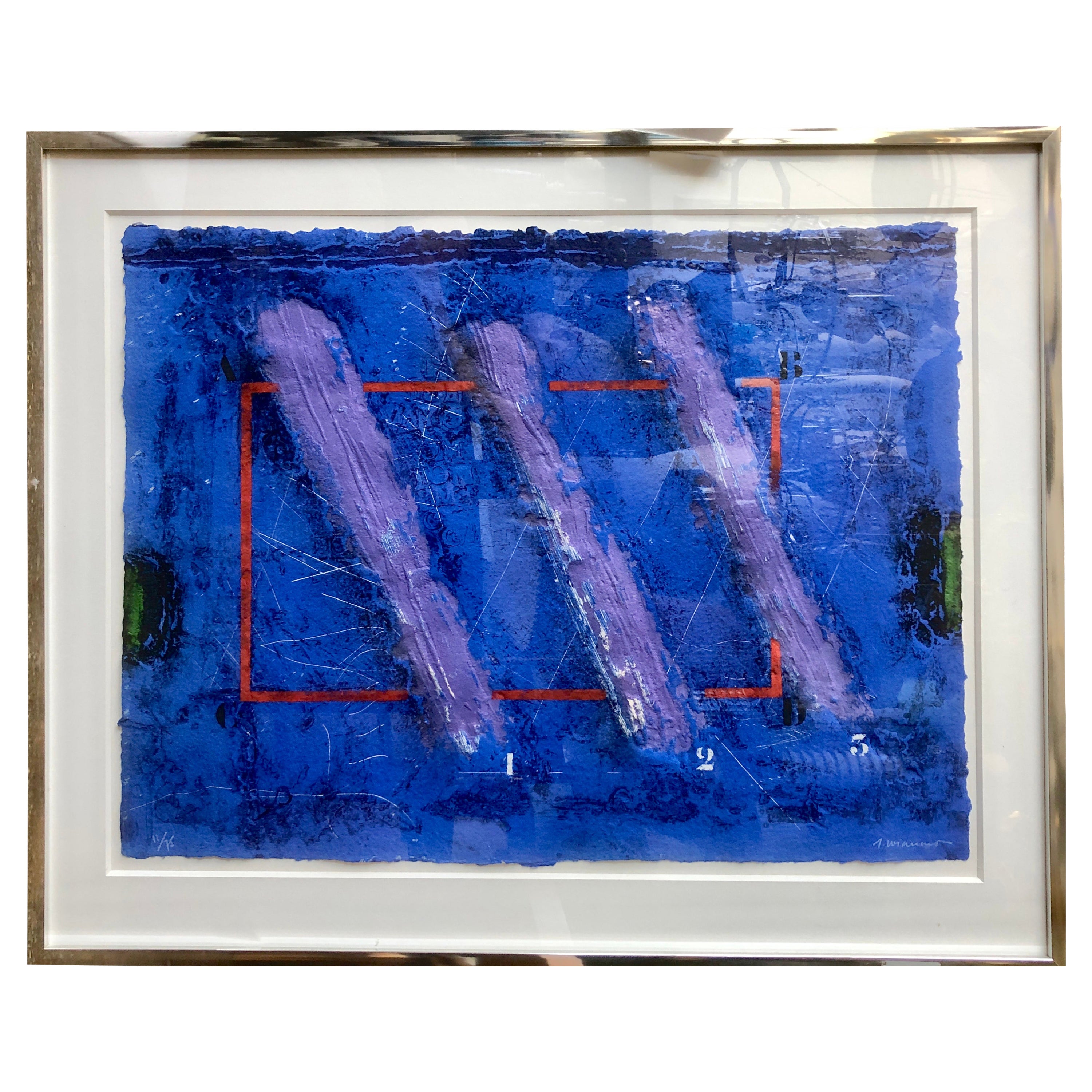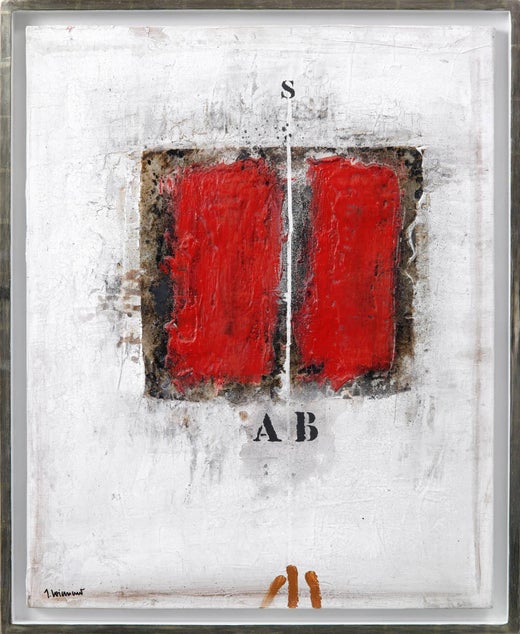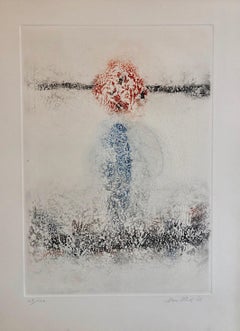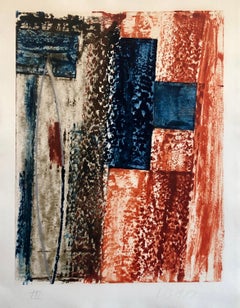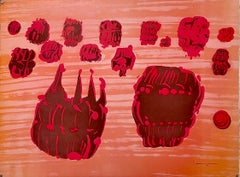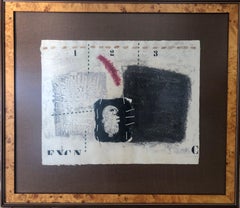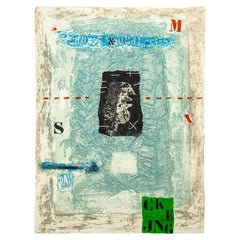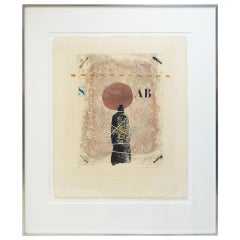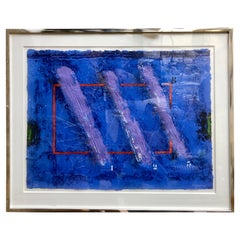Items Similar to French Pop Art Modernist Textured Carborundum Etching Abstract James Coignard
Want more images or videos?
Request additional images or videos from the seller
1 of 14
James CoignardFrench Pop Art Modernist Textured Carborundum Etching Abstract James Coignardc. 20th century
c. 20th century
$950
£705.32
€821.90
CA$1,318.91
A$1,475.28
CHF 767.74
MX$18,161.20
NOK 9,767.30
SEK 9,163.65
DKK 6,132.17
Shipping
Retrieving quote...The 1stDibs Promise:
Authenticity Guarantee,
Money-Back Guarantee,
24-Hour Cancellation
About the Item
Carborundum Etching by James Coignard (French, 1925-2008)
Signed and numbered 5/15. This might be a proof edition
Includes insert by Michel Bohbot
Frame: 22.5" X 18"
Image: 16.75" X 12.5"
James Coignard was born in Tours, France in 1925. At the age of three he moved to Paris with his parents. As a child he had an insatiable appetite for drawing and painting. In 1948, at 23 years of age, he made up his mind to become an artist and enrolled at the Ecole des arts Décoratifs in Nice. He apprenticed under the well-known painter Marchand des Raux. The following year the two of them staged a joint exhibition at the Musa de L’ile de France in St. Jean Cap Ferrat. Around the same time Coignard came into contact with the great Henri Matisse and was influenced by his work but soon began to seek his own ways forward. Not long afterwards, Coignard discovered the modernist™ handling of color via the techniques of Georges Braque and Marc Chagall. In both his mixed media on canvas and his works on paper, James Coignard is known for his technical versatility and use of vibrant primary colors. Coignard achieves a deep, heavy texture which is distinctive trait in his art.
With just a few strokes of his brush he conjures up an entire world. James Coignard extends the boundaries between concrete and abstract. He knows how to create chromatic melodies that shift in timbre from cobalt blue to blood red, from earthy tones to blocks of color as black as night. His paintings embrace everything from vast expanses of color to spaces enclosed. His pictures are an artistic epicenter where lines, letters and numbers mold with vigorous swashes of color. His paintings and graphic works are an artistic adventure, an aesthetic game in which the destructive and the momentous mingle freely with the spontaneous and the sensual.
His contact in the late 1950s with a number of Spanish artists and his special fascination for Catalan sculptures and frescoes proved decisive for his artistic development. In the 1960’s he began to create sculptures in bronze and glass, which he has continued to produce parallel with his paintings and graphic work. In the late 1960s Coignard produced his first etchings in the gravure au carborundum technique. The carborundum process of printmaking was developed by Henri Goetz in the 1960’s. It was Goetz himself that taught Coignard and other artists the use of carborundum for printmaking.
Since his first solo exhibition in Paris in 1960, Coignard has exhibited in major galleries and museums throughout the world, and is well represented in both private and public collections that include the Guggenheim Museum in New York and the Museum of Modern Art in San Francisco, California. He is represented by the Paule Friedland & Alexandre Rivault Gallery in Paris and edited by the Pasnic print house in Paris. James Coignard’s principal modes of expression were oil on canvas and gravure au carborundum, but also in bronze and glass sculptures as well as in ceramics. His work has been shown on more than 400 exhibitions, primarily in Central Europe and Scandinavia, but also in Canada and the USA. His first Swedish exhibition was at Malmö Museum in 1956. The early 1970s saw the start of a long-term liaison with Galleri Östermalm in Stockholm, owned by Editions Sonet. They came to represent him in Scandinavia and edited several volumes of his graphic works.
- Creator:James Coignard (1925-2008, French)
- Creation Year:c. 20th century
- Dimensions:Height: 22.5 in (57.15 cm)Width: 18 in (45.72 cm)
- Medium:
- Movement & Style:
- Period:
- Condition:Please refer to photos.
- Gallery Location:Surfside, FL
- Reference Number:1stDibs: LU38215150252
James Coignard
James Coignard, painter, ceramist, sculptor and etcher, was born in Tours in 1925. At the age of 23 and after a brief career in the French administration, he discovers the landscapes of the French Riviera and decides to study at Arts décoratifs in Nice. Four years later, he quits his job at the administration to commit himself entirely to his artistic career. The encounter with Paul Hervieu in 1950 is decisive. His collaboration with gallery Hervieu made him known in artistic circles, nationally and internationally and then particularly in Scandinavia. At the beginning of his career, art critics label James Coignard as a member of Ecole de Paris. Soon, his painting and ceramic distances themselves from those of his colleagues and he goes it alone. At the beginning of the sixties, he starts to work with glass but the technical turning point occurs in 1968 when his friend Henri Goetz discovers a new etching technique, using carborundum. Etching then becomes central in his work. At the same time, his career takes off internationally. He travels a lot, especially to Sweden and USA where he lives during a few years. 1978, James Coignard participates in the creation of the etching studio Pasnic, with which he starts a long collaboration. During the eighties, he shares his time between Paris and the French Riviera and takes an interest in artist’s books and publishing issues. He exhibits now all over the world, and is acknowledged as one of the greatest painter-etchers of his time. Until his decease in 2008, James Coignard was a prolific painter, sculptor and etcher and leaves behind an immense work.
About the Seller
4.9
Platinum Seller
Premium sellers with a 4.7+ rating and 24-hour response times
Established in 1995
1stDibs seller since 2014
1,777 sales on 1stDibs
Typical response time: 1 hour
- ShippingRetrieving quote...Shipping from: Surfside, FL
- Return Policy
Authenticity Guarantee
In the unlikely event there’s an issue with an item’s authenticity, contact us within 1 year for a full refund. DetailsMoney-Back Guarantee
If your item is not as described, is damaged in transit, or does not arrive, contact us within 7 days for a full refund. Details24-Hour Cancellation
You have a 24-hour grace period in which to reconsider your purchase, with no questions asked.Vetted Professional Sellers
Our world-class sellers must adhere to strict standards for service and quality, maintaining the integrity of our listings.Price-Match Guarantee
If you find that a seller listed the same item for a lower price elsewhere, we’ll match it.Trusted Global Delivery
Our best-in-class carrier network provides specialized shipping options worldwide, including custom delivery.More From This Seller
View All60s American Abstract Expressionist Untitled Abstract Color Composition Etching
By Don Fink
Located in Surfside, FL
Color Abstract Expressionism aquatint etching. hand pencil signed limited edition.
Don Fink (1923-2010) was a well known and well listed Abstract Expressionist who studied at the Art Students League and the Academie Julian. He was born in Duluth , Minnesota, but later moved to Europe where he established himself as an artist. He was first based in Paris where he was a member of the "Jeune École de Paris" (with Karel Appel, Debre, Friedensreich Hundertwasser, Antoni Tapies, Dumitresco, Messagier, Zanartu , etc.) and later moved to Barcelona.
A large retrospective of his earlier works was held in Madrid in 1998 with the following promotion:
Don Fink Returns to Madrid:
American "action" painter Don Fink (b. Duluth, Minnesota, 1923) has a show at Galería Rayuela through September 25. The artist divides his time between Barcelona, Paris, and New York. This is his second exhibition in Madrid in four years. The works on view date from 1952 to 1970. Their "active" surfaces meld the arts of tattooing, calligraphy and three-dimensional terrain mapping, resulting in a meditative and rewarding experience for the viewer. The show was organized by Sebastià Janè of Barcelona and Carmen Muro of Madrid. Galería Rayuela is at Calle Claudio Coello...
Category
20th Century Abstract Expressionist Abstract Prints
Materials
Etching, Aquatint
French Pop Art Modernist Textured Painting Abstract With Stencilled Letters
By James Coignard
Located in Surfside, FL
This is a mixed media abstract painting collage with string, plaster texture, stencilled letters in a bold typeface. Size includes frame.
James Coignard was born in Tours, France in...
Category
20th Century Post-War Abstract Paintings
Materials
Jute, Mixed Media, Oil, Board
Abstract Expressionist American Modernist Oil Monotype Monoprint Painting
By Larry Brown
Located in Surfside, FL
Larry Brown
Long-time established New York painter as well as faculty member the The Cooper Union, Brown works in oil on canvas and tempera paints on paper. He deals with themes of science and universality.
EDUCATION:
1970 M.F.A. in Painting, University of Arizona
1967 BA in Painting, Washington State University
SELECT GROUP EXHIBITIONS:
Mixed Company: Women Choose Men, AIR Gallery, New York, NY
Easy Breezy, Sears-Peyton Gallery, New York, NY
From Stone and Plate: Contemporary Prints from Tamarind Institute, California State University
Change of View Tamarind Institute Gallery, Albuquerque, NM
Animal As Muse, The Norton Museum of Art, W. Palm Beach, FL
Painting--Larry Brown, Joseph Haske, David Schoffman, Helander Gallery, New York, NY
Paper Houses, David Beitzel Gallery, New York, NY
Curators Choice, Albright-Knox Art Gallery, Buffalo, NY
Current Trends in Abstraction-- Larry Brown, Bill Drew...
Category
1980s Abstract Expressionist Abstract Paintings
Materials
Monoprint, Monotype
Pietro Consagra Italian Mod Abstract Expressionist Forma Brutalist Lithograph
By Pietro Consagra
Located in Surfside, FL
Pietro Consagra (Italian, 1920-2005).
Hand signed in pencil and numbered limited edition color lithograph on Magnani paper.
Embossed stamp with limited edition numbers in pencil to lower left, and having artist pencil signature to lower right.
(from a limited edition of 80 with 15 artist's proofs)
Published by Stamperia 2RC, Rome Italy and Marlborough Gallery, Rome, Italy.
Abstract Modernist work in colors, produced in the style of the Forma art movement of Postwar Italy, of which the artist was a prominent member.
Pietro Consagra (1920 – 2005) was an Italian Post war artist working in painting, printmaking and sculpture. In 1947 he was among the founding members of the Forma 1 group of artists, proponents of structured abstraction.
Consagra was born on 6 October 1920 in Mazara del Vallo, in the province of Trapani in south-western Sicily, to Luigi Consagra and Maria Lentini. From 1931 he enrolled in a trade school for sailors, studying first to become a mechanic, and later to become a captain. In 1938 he moved to Palermo, where he enrolled in the liceo artistico; despite an attack of tuberculosis, he graduated in 1941, and in the same year signed up at the Accademia di Belle Arti, where he studied sculpture under Archimede Campini. After the Invasion of Sicily and the Allied occupation of Palermo in 1943, Consagra found work as a caricaturist for the American Red Cross club of the city; he also joined the Italian Communist Party. Early in 1944, armed with a letter of introduction from an American officer, he travelled to Rome. There he came into contact with the Sicilian artist Concetto Maugeri, and through him with Renato Guttuso, who was also Sicilian and who introduced him to the intellectual life of the city and to other postwar artists such as Leoncillo Leonardi, Mario Mafai and Giulio Turcato. Consagra signed up at the Accademia di Belle Arti di Roma in September 1944 and studied sculpture there under Michele Guerrisi, but left before completing his diploma.
In 1947, with Carla Accardi, Ugo Attardi, Piero Dorazio, Mino Guerrini, Achille Perilli, Antonio Sanfilippo and Giulio Turcato, Consagra started the artist's group Forma 1, which advocated both Marxism and structured abstraction.
Steadily Consagra's work began to find an audience. Working primarily in metal, and later in marble and wood, his thin, roughly carved reliefs, began to be collected by Peggy Guggenheim and other important patrons of the arts. He showed at the Venice Biennale eleven times between 1950 and 1993, and in 1960 won the sculpture prize at the exhibition. During the 1960s he was associated with the Continuità group, an offshoot of Forma I, and in 1967 taught at the School of Arts in Minneapolis. Large commissions allowed him to begin working on a more monumental scale, and works of his were installed in the courtyard of the Foreign Ministry in Rome and in the European Parliament, Strasbourg. His work is found in the collections of The Tate Gallery, London, in Museo Cantonale d'Arte of Lugano and the Museum of Modern Art, Paris, and the National Gallery of Art in Washington, D.C..
Consagra returned to Sicily where he sculpted a number of significant works during the 1980s. With Senator Ludovico Corrao, he helped created an open-air museum in the new town of Gibellina, after the older town had been destroyed in the earthquake of 1968. Consagra designed the gates to the town's entrance, the building named "Meeting" and the gates to the cemetery, where he was later buried.
In 1952 Consagra published La necessità della scultura ("the need for sculpture"), a response to the essay La scultura lingua morta ("sculpture, a dead language"), published in 1945 by Arturo Martini. Other works include L'agguato c'è ("the snare exists", 1960), and La città frontale ("the frontal city", 1969). His autobiography, Vita Mia, was published by Feltrinelli in 1980. In 1989 a substantial retrospective exhibition of work by Consagra was shown at the Galleria Nazionale d'Arte Moderna in Rome; in 1993 a permanent exhibition of his work was installed there. In 1991 his work was shown in the Hermitage Museum in St. Petersburg. In 2002 the Galerie der Stadt Stuttgart opened a permanent exhibition of his work. He was one of ten artists invited by Giovanni Carandente, along with David Smith, Alexander Calder, Arnaldo Pomodoro, Lynn Chadwick, and Beverly Pepper, to fabricate works in Italsider factories in Italy for an outdoor exhibition, "Sculture nella città", held in Spoleto during the summer of 1962. He was included in the The 1962 International Prize for Sculpture the jury included Argan, Romero Brest and James Johnson Sweeney the former director of the Solomon R. Guggenheim Museum in New York. The participants included Louise Nevelson and John Chamberlain for the United States; Lygia Clark for Brazil; Pietro Consagra, Lucio Fontana, Nino Franchina, and Gió Pomodoro for Italy; Pablo Serrano for Spain; and Eduardo Paolozzi, William Turnbull, and Kenneth Armitage for England. Gyula Kosice, Noemí Gerstein, Julio Gero, Naum Knop...
Category
1960s Abstract Expressionist Abstract Prints
Materials
Lithograph
Lacuna, Abstract Expressionist Color Etching from Graphicstudio, Hugh O'Donnell
By Hugh O'Donnell
Located in Surfside, FL
Hand signed and numbered from edition of 50. size includes frame.
Hugh O'Donnell is an English painter, printmaker and site-specific artist. Born in London in 1950. From 1968–74 he ...
Category
1990s Abstract Expressionist Abstract Prints
Materials
Etching
Pietro Consagra Italian Mod Abstract Expressionist Forma, Art Brut Lithograph
By Pietro Consagra
Located in Surfside, FL
Pietro Consagra (Italian, 1920-2005).
Hand signed in pencil and numbered limited edition color lithograph on Magnani paper.
Embossed stamp with limited edition numbers in pencil to lower left, and having artist pencil signature to lower right.
(from a limited edition of 80 with 15 artist's proofs)
Published by Stamperia 2RC, Rome Italy and Marlborough Gallery, Rome, Italy.
Abstract Modernist work in colors, produced in the style of the Forma art movement of Postwar Italy, of which the artist was a prominent member.
Pietro Consagra (1920 – 2005) was an Italian Post war artist working in painting, printmaking and sculpture. In 1947 he was among the founding members of the Forma 1 group of artists, proponents of structured abstraction. (similar to the Art Informel and Art Brut in France and the Brutalist artists)
Consagra was born on 6 October 1920 in Mazara del Vallo, in the province of Trapani in south-western Sicily, to Luigi Consagra and Maria Lentini. From 1931 he enrolled in a trade school for sailors, studying first to become a mechanic, and later to become a captain. In 1938 he moved to Palermo, where he enrolled in the liceo artistico; despite an attack of tuberculosis, he graduated in 1941, and in the same year signed up at the Accademia di Belle Arti, where he studied sculpture under Archimede Campini. After the Invasion of Sicily and the Allied occupation of Palermo in 1943, Consagra found work as a caricaturist for the American Red Cross club of the city; he also joined the Italian Communist Party. Early in 1944, armed with a letter of introduction from an American officer, he travelled to Rome. There he came into contact with the Sicilian artist Concetto Maugeri, and through him with Renato Guttuso, who was also Sicilian and who introduced him to the intellectual life of the city and to other postwar artists such as Leoncillo Leonardi, Mario Mafai and Giulio Turcato. Consagra signed up at the Accademia di Belle Arti di Roma in September 1944 and studied sculpture there under Michele Guerrisi, but left before completing his diploma.
In 1947, with Carla Accardi, Ugo Attardi, Piero Dorazio, Mino Guerrini, Achille Perilli, Antonio Sanfilippo and Giulio Turcato, Consagra started the artist's group Forma 1, which advocated both Marxism and structured abstraction.
Steadily Consagra's work began to find an audience. Working primarily in metal, and later in marble and wood, his thin, roughly carved reliefs, began to be collected by Peggy Guggenheim and other important patrons of the arts. He showed at the Venice Biennale eleven times between 1950 and 1993, and in 1960 won the sculpture prize at the exhibition. During the 1960s he was associated with the Continuità group, an offshoot of Forma I, and in 1967 taught at the School of Arts in Minneapolis. Large commissions allowed him to begin working on a more monumental scale, and works of his were installed in the courtyard of the Foreign Ministry in Rome and in the European Parliament, Strasbourg. His work is found in the collections of The Tate Gallery, London, in Museo Cantonale d'Arte of Lugano and the Museum of Modern Art, Paris, and the National Gallery of Art in Washington, D.C..
Consagra returned to Sicily where he sculpted a number of significant works during the 1980s. With Senator Ludovico Corrao, he helped created an open-air museum in the new town of Gibellina, after the older town had been destroyed in the earthquake of 1968. Consagra designed the gates to the town's entrance, the building named "Meeting" and the gates to the cemetery, where he was later buried.
In 1952 Consagra published La necessità della scultura ("the need for sculpture"), a response to the essay La scultura lingua morta ("sculpture, a dead language"), published in 1945 by Arturo Martini. Other works include L'agguato c'è ("the snare exists", 1960), and La città frontale ("the frontal city", 1969). His autobiography, Vita Mia, was published by Feltrinelli in 1980. In 1989 a substantial retrospective exhibition of work by Consagra was shown at the Galleria Nazionale d'Arte Moderna in Rome; in 1993 a permanent exhibition of his work was installed there. In 1991 his work was shown in the Hermitage Museum in St. Petersburg. In 2002 the Galerie der Stadt Stuttgart opened a permanent exhibition of his work. He was one of ten artists invited by Giovanni Carandente, along with David Smith, Alexander Calder, Arnaldo Pomodoro, Lynn Chadwick, and Beverly Pepper, to fabricate works in Italsider factories in Italy for an outdoor exhibition, "Sculture nella città", held in Spoleto during the summer of 1962. He was included in the The 1962 International Prize for Sculpture the jury included Argan, Romero Brest and James Johnson Sweeney the former director of the Solomon R. Guggenheim Museum in New York. The participants included Louise Nevelson and John Chamberlain for the United States; Lygia Clark for Brazil; Pietro Consagra, Lucio Fontana, Nino Franchina, and Gió Pomodoro for Italy; Pablo Serrano for Spain; and Eduardo Paolozzi, William Turnbull, and Kenneth Armitage for England. Gyula Kosice, Noemí Gerstein, Julio Gero, Naum Knop...
Category
1960s Abstract Expressionist Abstract Prints
Materials
Lithograph
You May Also Like
Untitled Carborundum color etching and collage
By James Coignard
Located in Lake Worth Beach, FL
Untitled, Carborundum color etching and collage with / string embroidery, signed and numbered 69/75, about 20x26 inches. Excellent condition.
JAMES COIGNARD (1925-2008)
Painter of S...
Category
1970s Abstract Expressionist Abstract Prints
Materials
Etching
James Cognard Signed Postmodern Carborundum Etching on Hand Made Paper
Located in Keego Harbor, MI
A postmodern carborundum etching on hand made paper by James Coignard. Hand signed in pencil lower right with an annotation of V/XV on the lower left. Published circa 1970s. Geometri...
Category
Vintage 1970s French Post-Modern Paintings
Materials
Paper
James Coignard Carborundum Etching
Located in Den Haag, NL
Carborundum etching mix-media on paper by the Great French artist, James Coignard
signed. And on the left corner EA Epreuve d’Artiste Artist Proof. Good condition.
Framed 1970s.
Category
Vintage 1970s French Post-Modern Contemporary Art
Materials
Paper
James Coignard Large Carborundum Etching
Located in Long Island City, NY
" Diagonales Violettes", large carborundum etching with emboss by James Coignard ( 1925-2008). France.
Signed and numbered. Framed. Dimensions; 30'x23" ( framed 37"x30").
Category
1990s French Modern Prints
Materials
Paper
$2,000 Sale Price
20% Off
Abstract mixed media lithograph and relief by Spanish artist, Picasso friend S/N
By Antoni Clavé
Located in New York, NY
Antoni Clavé
Untitled, from the Album International 2 Portfolio, 1977
Mixed media: Lithograph in relief
29 1/4 × 19 3/4 inches
Edition 1/50
Signed and number on front
Unframed
This is a rare lithograph by the world renowned Catalan graphic artist, painter and sculptor, signed and numbered in pencil from the limited edition of only 50. Superb provenance as it is was acquired from the original Album International Portfolio, number 1 of 50.
Text from the Colophon page reads as follows:
Born in Barcelona, living in St. Tropez, France.
Lithograph in relief, edition of 50, each numbered and signed by the artist.
Antoni Clavé biography
Antoni Clavé was born in Barcelona on April 5th, 1913. From 1926 he attended evening courses at the Escuela de Artes y Oficios "Llotja", a school both Picasso and Miró attended in their youth. In 1927, one of Clavé's teachers found him a position as a house painter's apprentice because of his growing fascination with the hands-on nature of painting and especially with the materials used for such work, like learning how to prepare paints.
In 1932, Clavé stopped attending evening classes and, on the recommendation of Illescas, an architect, was employed at the firm of Cinaes, where he designed the weekly cinema posters.
During the Spanish Civil War (1936-1939), he served as a draughtsman for the Republican government but eventually was forced to flee to France. After a brief internment at Les Haras camp in Perpignan, Clavé settled in Paris in 1939 without any papers, drawing comics and working as an illustrator to get by.
In the 1940s Clavé's work showed the stylistic influence of Bonnard and Vuillard, until he met fellow Spanish expatriate Pablo Picasso in 1944. This meeting marked a pivotal change in Clavé's style, and he was forever grateful to be considered a lifelong friend of Don Pablo, as he called him.
From 1946, Clavé created numerous designs for the ballet and theatre in Paris, Munich, London and New York and in the 1950s, he turned to book illustration. He was nominated for two Academy Awards (Best Art Direction and Best Costume Design) for his work on the 1952 film Hans Christian Andersen.
In 1954, Clavé ceased working as a stage-set designer and illustrator to devote himself entirely to painting, visiting Spain again. His paintings became more abstract and enigmatic; inspired by wall...
Category
1970s Abstract Abstract Prints
Materials
Mixed Media, Lithograph
Abstract Composition - Original Mixed Media Etching on Paper - Late 20th Century
Located in Roma, IT
Abstract Composition is a little mixed media etching realized by an artist of late 20th century.
In good conditions the artwork is mounted on a white cardboard (24x30).
No signatur...
Category
Late 20th Century Contemporary Mixed Media
Materials
Mixed Media, Etching
